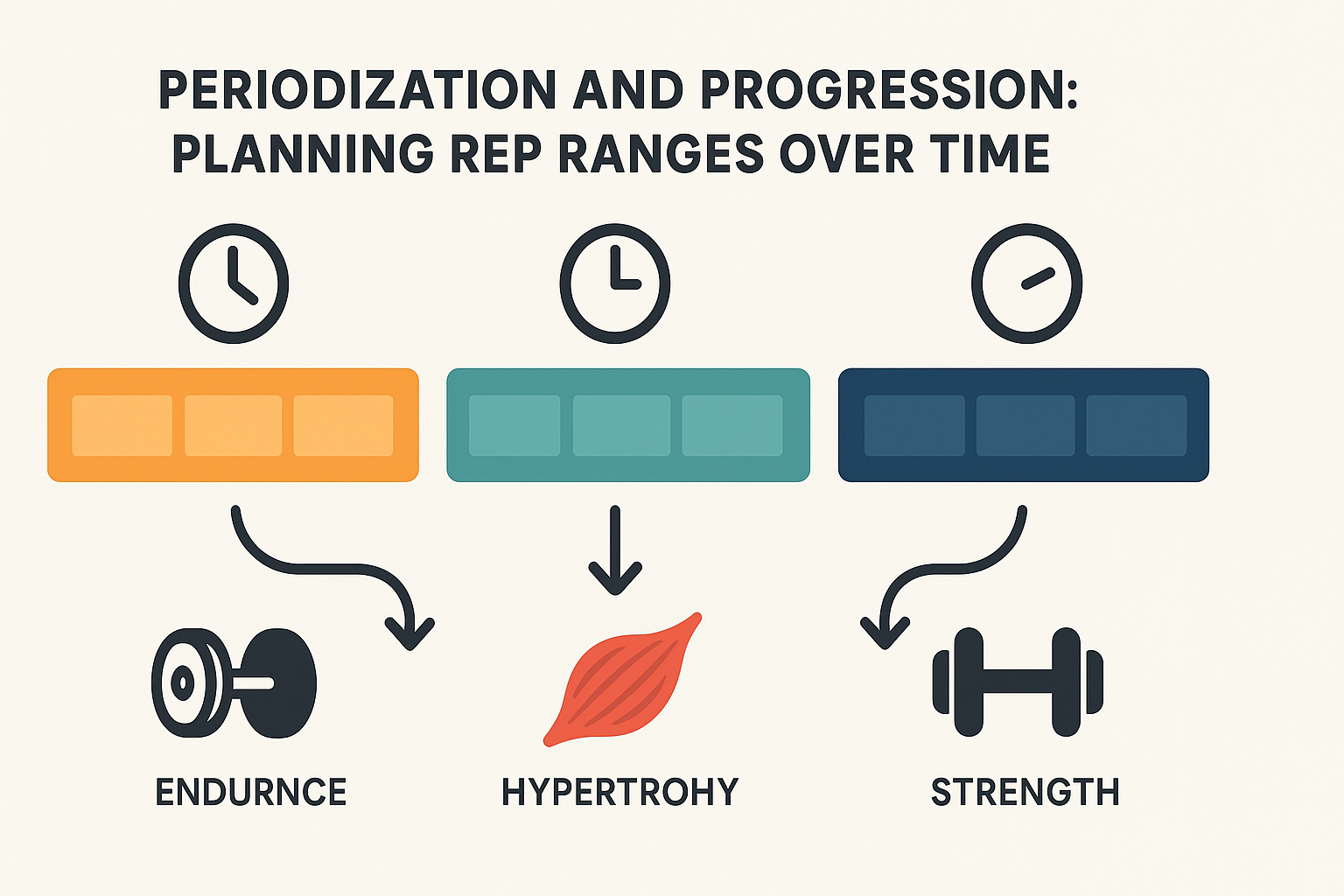Introduction: Unlocking the Science Behind Rep Ranges and Muscle Building
In the world of resistance training, few concepts are as essential—or as misunderstood—as rep ranges. These numerical parameters, which dictate how many times you perform a specific movement in a single set, are foundational to achieving precise fitness outcomes. Whether your aim is to gain raw strength, build lean muscle mass, or improve muscular endurance, the rep ranges you choose play a pivotal role in steering your progress. For anyone serious about sculpting a powerful physique, understanding how to tailor reps and sets for muscle growth is not optional—it’s critical.
This guide will unpack the science of repetition ranges and demonstrate how to use them to your advantage. By exploring evidence-based programming approaches, we’ll answer vital questions like how many repetitions to build muscle, how many reps for strength, and the best rep range for hypertrophy. The goal is to help you harness the full potential of your training by selecting repetition schemes that match your objectives, biology, and training history. As you’ll discover, rep ranges are not simply numbers—they are strategic tools that shape your muscular development and performance capacity.
You may also like: The Ultimate Hypertrophy Workout Program for Building Strength and Size

Why Rep Ranges Matter: The Bridge Between Stimulus and Adaptation
Before we delve into specifics, it’s important to understand why rep ranges matter. Each range corresponds to a different adaptation pathway in the body, influencing muscle fiber recruitment, hormonal response, and metabolic stress. Low rep schemes, typically between 1 to 5 reps, maximize motor unit recruitment and develop neural efficiency. These are most often associated with strength gains and improved force output. In contrast, moderate rep ranges (6–12 reps) stimulate a balance of mechanical tension and metabolic stress, which supports hypertrophy. High reps (15+), though sometimes dismissed, can enhance muscular endurance and increase time under tension—an underrated hypertrophic trigger when taken close to failure.
One reason rep ranges are so influential is that they dictate how much weight you lift. Heavier loads necessitate fewer reps, placing greater stress on the nervous system. Lighter loads allow for more volume and metabolic buildup. This interplay determines how strength training reps and sets affect your adaptations over time. When people ask, how many reps to gain muscle or how many reps for muscle growth, the correct response must take into account both the mechanical and biochemical impacts of these repetition schemes.
A further dimension is training volume, which is the product of sets, reps, and weight. Understanding how many sets and reps to build muscle ensures that you’re not only selecting effective rep ranges but also applying enough cumulative stress to drive adaptation. This nuanced approach allows athletes to make informed decisions rather than blindly following generic programs.

Rep Ranges for Strength: Programming with Low Repetitions for Maximal Power
Strength training is fundamentally about teaching your body to produce more force. The rep range for strength—usually defined as 1 to 5 repetitions per set—is specifically tailored to this goal. Training within this range encourages the recruitment of high-threshold motor units and fast-twitch muscle fibers, which are essential for explosive power. These sessions are typically performed at 80–95% of an individual’s one-rep max, pushing both muscle and nervous systems to their limit.
For those wondering how many reps for strength are ideal, the answer lies in understanding both physiological response and recovery. Heavy lifting sessions require more recovery between sets, often 2 to 5 minutes, to allow for full ATP replenishment. The number of sets per movement is generally lower than hypertrophy training, but the overall intensity is higher. Research suggests that 3 to 6 sets of 3 to 5 reps on compound lifts like deadlifts, squats, and bench presses are effective for strength development.
Programming also involves considering how many sets per workout are sustainable over time. Exceeding your recovery capacity not only stalls progress but increases the risk of injury. A well-structured strength program incorporates deload weeks and periodized phases to ensure long-term gains. By focusing on correct rep and set schemes for strength, lifters build the neuromuscular coordination required to handle progressively heavier loads safely and efficiently.

Proven Rep Ranges for Hypertrophy: Building Muscle with Purpose
The question of the best rep range for hypertrophy is one of the most commonly debated topics in fitness. Scientific literature and empirical evidence both support moderate rep ranges—typically between 6 and 12 reps—as the most efficient for stimulating muscle growth. This range allows for lifting relatively heavy loads while performing enough reps to induce muscle damage and metabolic stress, two key drivers of hypertrophy.
When lifters ask how many reps for hypertrophy or how many reps to build muscle, the answer is rarely absolute. Hypertrophy can occur in a wide spectrum of rep ranges, provided the sets are taken close to muscular failure. However, the 6–12 range strikes the best balance between load and fatigue, making it more practical for long-term progress. For example, training with 8 to 10 reps per set at 70–80% of your 1RM encourages both sarcoplasmic expansion and myofibrillar growth—meaning your muscles get bigger and stronger simultaneously.
Volume is equally important when determining how many sets and reps to gain muscle. A general guideline is to perform 10 to 20 total sets per muscle group per week, distributed across multiple sessions. This total can be achieved through 3 to 4 sets per exercise and 2 to 3 exercises per muscle group. Knowing how many sets per muscle group works best for your body will require some experimentation and tracking, but these numbers offer a strong starting point.

Integrating High Rep Sets: Endurance and Hypertrophy Synergy
While moderate rep ranges dominate most hypertrophy programs, higher rep schemes—typically 15 to 20+ reps—have a unique role to play. These longer sets create extended time under tension and generate high levels of metabolic stress, which are essential for stimulating certain muscle fibers, particularly type I (slow-twitch) fibers. High-rep sets also improve muscular endurance and vascularization, making them valuable for improving performance and recovery capacity.
Some athletes find that high-rep training provides better mind-muscle connection, especially for isolation exercises like lateral raises, leg extensions, and cable crossovers. These movements benefit from lighter loads, which reduce joint strain while still challenging the muscle. Answering how many reps in a set for endurance-focused hypertrophy can vary, but sets of 15 to 25 reps near failure can enhance muscular definition and increase training density without overwhelming the central nervous system.
High-rep training should be used strategically rather than as a primary modality. When combined with moderate and low-rep schemes, it creates a comprehensive stimulus that targets all muscle fiber types. For example, a chest workout might begin with low-rep barbell bench presses, transition to moderate-rep dumbbell presses, and conclude with high-rep cable flys. This layered approach reinforces the benefits of various rep ranges while avoiding redundancy and adaptation.
How Many Sets and Reps to Build Muscle: Structuring Volume for Success
Training volume is one of the strongest predictors of muscle growth, and understanding how many sets and reps to build muscle is foundational for program design. For hypertrophy, a standard recommendation is 3 to 5 sets per exercise and 8 to 12 reps per set. These numbers are flexible based on exercise selection, muscle group size, and individual recovery capacity, but they offer a reliable framework for consistent results.
Determining how many sets per exercise depends on training frequency and movement complexity. Compound lifts like squats and pull-ups may require fewer sets due to their systemic impact, while smaller movements like curls or lateral raises can handle more. A typical hypertrophy session might include 4 exercises per muscle group with 3 to 4 sets each, resulting in 12 to 16 sets per muscle group. This ensures enough volume to trigger adaptation while respecting the body’s recovery needs.
The question how many sets should I do can also depend on periodization. During accumulation phases, more volume may be appropriate, while deload or strength-focused phases may reduce total sets to maintain performance. The key is managing weekly volume and intensity to prevent overtraining. Tracking progress and adjusting volume based on performance markers—such as load progression and perceived effort—provides a smarter way to build muscle than blindly increasing training time.

Rep Ranges for Different Goals: Customizing Based on Individual Needs
One of the greatest advantages of understanding rep ranges is the ability to customize training based on your specific goals. Someone looking to increase maximal strength will benefit most from low reps and high loads, while a bodybuilder focused on aesthetics should prioritize moderate reps and high volume. Conversely, an endurance athlete may find higher rep ranges with shorter rest intervals more effective for supporting their sport.
This goal-based approach answers broader questions like how many reps should I do or how many sets to do to build muscle with precision. Rather than relying on generic answers, athletes can align their rep and set schemes with their desired outcomes. For instance, a powerlifter might employ a 5×3 structure at 85% 1RM, while a physique athlete might prefer 4×10 at 70% 1RM with short rest periods. These structures support different adaptations—neurological efficiency versus metabolic fatigue—and cater to different athletic needs.
Even within a single workout, different rep schemes can coexist. A strength-focused session might begin with low-rep squats and finish with high-rep lunges. This mixed-method approach ensures that both performance and muscle development are addressed. The key is to let your goals guide your structure while remaining flexible enough to adapt based on how your body responds over time.

Periodization and Progression: Planning Rep Ranges Over Time
Sustainable progress in strength and hypertrophy training requires intelligent planning, and this is where periodization becomes indispensable. Periodization involves systematically varying training variables—like volume, intensity, and rep ranges—to optimize performance and avoid plateaus. Linear periodization might involve gradually increasing intensity and lowering reps over weeks, while undulating periodization alternates rep schemes more frequently within the same week.
For example, a classic 12-week program might begin with 3 weeks of 12–15 reps to establish a volume base, transition to 3 weeks of 8–10 reps for hypertrophy, and culminate in 3 weeks of 4–6 reps for strength. This method ensures progressive overload while minimizing fatigue accumulation. Lifters who plateau often fail to periodize properly, repeating the same reps and sets for strength or growth without adjusting load or intensity.
Strategic variation also reduces the risk of injury by preventing overuse. Shifting from barbell to dumbbell exercises, changing angles, or modifying tempo can provide enough novelty to stimulate adaptation without abandoning your program’s core structure. Periodization allows for goal-specific programming while also accounting for the psychological benefits of variety and challenge.

Recovery, Frequency, and Long-Term Adaptation
No discussion of rep ranges is complete without considering recovery. The most scientifically optimized training program will fail if the body doesn’t have time to adapt. Recovery is influenced by sleep, nutrition, stress levels, and total training volume. High-intensity, low-rep strength work is more taxing on the nervous system and requires longer recovery periods, while moderate and high-rep schemes allow for quicker bounce-back.
Training frequency also plays a role. Performing 10 to 20 sets per muscle group per week is a reliable benchmark, but spreading that volume over 2 to 3 sessions enhances recovery and performance. For example, hitting chest twice per week with 5 sets per session is often more effective than cramming all 10 sets into one workout. This distribution allows for more quality reps and better muscle protein synthesis response.
By integrating appropriate rest periods, nutrition protocols, and deload strategies, lifters can maximize the impact of their rep range choices. Listening to biofeedback—such as soreness, joint discomfort, or declining performance—can signal when it’s time to adjust volume or intensity. Ultimately, the interplay between training and recovery dictates long-term success more than any individual set or rep count.
Frequently Asked Questions: Optimizing Strength and Muscle Growth with Smart Rep Ranges
What role do rep ranges play in long-term periodization for muscle development?
Rep ranges serve as the backbone of any periodized training strategy, helping structure progress over weeks, months, and even years. By cycling through low, moderate, and high rep ranges in a systematic way, athletes can avoid plateaus, reduce injury risk, and promote long-term muscle growth. For example, alternating between a mesocycle of 4–6 reps for strength followed by 8–12 reps for hypertrophy keeps both the nervous system and musculature challenged. This dynamic use of rep ranges also aids recovery by varying the stress placed on joints and connective tissue. Integrating intelligent progression through different rep ranges enhances muscle responsiveness and maximizes gains without burnout.
How many reps for muscle growth is ideal during a cutting or fat-loss phase?
When training during a fat-loss phase, the goal is to retain as much muscle mass as possible while in a caloric deficit. In this context, the best rep range for muscle growth typically remains in the 6–12 range, which preserves mechanical tension while preventing excessive fatigue that could hinder recovery. However, incorporating some sets in the 4–6 range can help maintain strength, which is a strong correlate of muscle retention. Asking how many reps for muscle growth during cutting also depends on energy availability—if recovery is compromised, volume may need to be adjusted downward while keeping intensity high. Ultimately, emphasizing quality over quantity in reps ensures continued hypertrophic stimulus even when in a deficit.
How can athletes customize rep ranges for lagging muscle groups?
Lagging muscle groups often require increased volume or frequency, but adjusting rep ranges is an overlooked method of improvement. For instance, if your deltoids are underdeveloped, alternating between low-rep, heavy presses and high-rep isolation movements can provide a multi-faceted stimulus. Including 3–5 reps for heavy pressing and 12–20 reps for lateral raises ensures full fiber recruitment and varied mechanical tension. This kind of targeted programming demands awareness of how many reps in a set can activate different fiber types. Using rep ranges creatively allows you to manipulate time under tension and recovery strategies tailored specifically to weaker muscle groups.
How do psychological factors influence adherence to different rep ranges?
Psychological engagement is an often-underestimated component of training success. Some individuals thrive on the challenge of low-rep maximal lifts, while others find high-rep sets more motivating due to the burn and perceived workload. Understanding how many repetitions to build muscle is not just about physiology—it’s about adherence and consistency. If a lifter dislikes the discomfort of 20-rep squats, they’re unlikely to stick with a program that emphasizes endurance hypertrophy. Conversely, someone averse to heavy lifting might benefit more from moderate to high reps with short rest intervals, provided the intensity remains high enough to drive muscle growth. Matching rep ranges with psychological preferences enhances sustainability and long-term progress.
Exploring the Best Rep Range for Hypertrophy in Different Age Groups
Age significantly affects the optimal rep range for hypertrophy due to differences in recovery, joint integrity, and anabolic responsiveness. While younger athletes may thrive on higher training intensities and moderate reps, older lifters often benefit from slightly higher rep ranges (10–20) with controlled tempo to reduce joint stress. When considering the best rep range for hypertrophy across age groups, it’s crucial to monitor recovery and inflammation markers. Older trainees may also require fewer sets per workout to prevent systemic fatigue, even if they maintain a high training frequency. Tailoring rep ranges by age helps ensure continued progress while minimizing injury risk and supporting hormonal health.
What’s the relationship between reps and the mind-muscle connection?
The mind-muscle connection—the conscious contraction and control of a muscle during movement—can be enhanced by adjusting rep ranges. Higher reps with lighter loads (12–20) allow more focus on muscle engagement and technique refinement. In contrast, low-rep sets often emphasize movement execution over contraction sensation, making them less suitable for developing this skill. For those struggling to develop certain muscle areas, shifting to higher reps can improve neuromuscular control and feedback. This approach is especially effective in exercises like cable flys or bicep curls, where form and feel outweigh brute force in importance. Understanding how many reps to build muscle through enhanced neural activation adds depth to traditional training approaches.
How Many Sets and Reps to Gain Muscle While Training at Home with Limited Equipment?
Training with minimal equipment doesn’t prevent muscle growth if sets and reps are adjusted properly. When heavy weights aren’t available, increasing reps to 20–30 per set and pushing close to failure can still create sufficient hypertrophic stimulus. In this case, the focus shifts to achieving effective reps—those final, challenging repetitions that stimulate muscle adaptation. Adjusting how many sets and reps to gain muscle at home may involve higher overall volume, including rest-pause sets or supersets to enhance training density. Including slow eccentrics and paused reps within these higher ranges compensates for lower load availability, allowing even bodyweight exercises to become growth-inducing.
How do rest periods interact with strength training reps and sets?
Rest periods are a crucial but often neglected variable in the context of strength training reps and sets. For low-rep, high-intensity training (1–5 reps), rest intervals of 2 to 5 minutes are necessary to fully replenish ATP and phosphocreatine stores, enabling maximal output on each set. On the other hand, shorter rest periods (30–90 seconds) are more suitable for hypertrophy-focused training in the 8–12 rep range, where metabolic stress plays a larger role. The interplay between rest duration and rep range also influences hormonal responses, such as transient spikes in growth hormone and testosterone. Understanding how rest periods complement rep schemes enhances not only performance but recovery and adaptation as well.
Customizing Reps and Sets for Muscle Growth During Rehabilitation or Injury Recovery
During rehabilitation, careful manipulation of sets and reps for muscle growth ensures continued progress without aggravating injury. Lower loads and higher reps (15–25) with slow tempos minimize joint strain while still stimulating hypertrophy through increased time under tension. This method is particularly useful for recovering from tendon-related injuries where mechanical load must be controlled. As healing progresses, transitioning to traditional hypertrophy ranges (8–12 reps) with progressive resistance reintroduces intensity without compromising safety. In this context, how many sets per muscle group may also need to be reduced initially and scaled gradually. Strategic progression of reps and sets safeguards recovery while preventing muscle atrophy.
What’s the future of training tech for optimizing rep ranges?
Emerging technologies in fitness are revolutionizing how athletes optimize rep ranges. Wearable EMG devices can now provide real-time feedback on muscle activation, helping users identify the most effective rep ranges for their physiology. Smart gym equipment, including AI-powered resistance machines, adjusts load automatically based on fatigue, ensuring users remain within ideal rep zones for hypertrophy or strength. Apps and trackers are also evolving to recommend adjustments to how many sets per workout or how many reps should I do based on performance trends and biometric data. This shift toward personalized, data-driven training is changing how we understand and apply repetition schemes. In the coming years, tech-assisted customization could redefine our understanding of reps to build muscle and the precise variables needed for peak performance.
Conclusion: Mastering Rep Ranges to Maximize Strength and Muscle Growth
In the pursuit of muscular size and strength, understanding and applying the right rep ranges is one of the most empowering tools available to any trainee. Far from being arbitrary numbers, these repetitions serve as the scaffolding upon which all muscular adaptations are built. Whether you’re experimenting with the best rep range for hypertrophy, figuring out how many reps to build muscle, or refining your approach to strength training reps and sets, the knowledge you now possess provides a strategic edge.
Optimal training outcomes demand more than effort; they require intention and precision. By aligning your rep and set schemes with your individual goals, recovery ability, and training experience, you position yourself for sustainable progress. When approached correctly, your workouts become more than a means to an end—they become a well-orchestrated system for unlocking your full physical potential.
As your journey evolves, remember that adaptation thrives on variation and progressive overload. Adjust your rep ranges periodically, monitor your body’s feedback, and never stop refining your approach. The question is no longer just how many reps should I do—it’s how can I best apply this knowledge to create lasting, meaningful results. And in that answer lies the true power of training with purpose.
Further Reading:
Research Has Unveiled How Many Sets You Need to Do to Build Muscle





